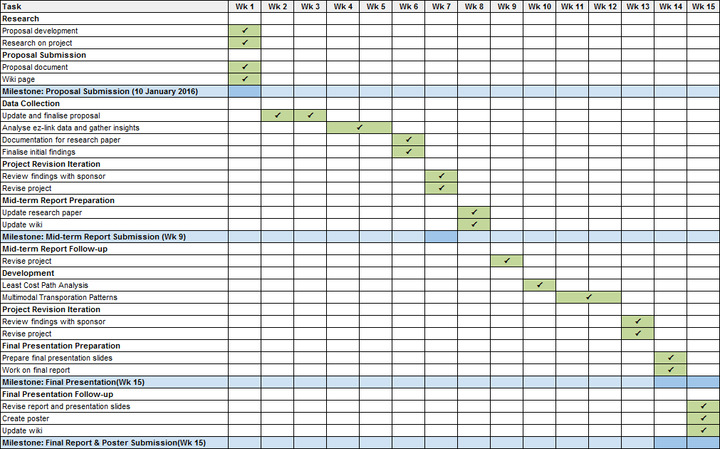AY1516 T2 Team WalkThere Methodology
Contents
Methodology
Part 1: Identify Commuter Patterns
This analysis aims to identify commuter patterns of each demographic groups - students, adults and elderly - as each group has differing interests and preferences in the places to frequent at. These patterns are recognized by areas with high volumes of people commuting by bus using the ez-link data. We aim to identify any commonalities where people travel for short distances, with only a few bus stops, within journeys, as well as recognize what are the common places of interests that the various demographic groups frequent at and at what periods of the week.
Our data for this analysis consists of the following:
1.Ez-link transactions
With the support from LARC, we were able to obtain ez-link transactions data from 20 to 26 January 2014. We have selected just a week of data in January 2014 because the travelling patterns for each week in a month are similar and there are neither no public holidays nor school holidays in the selected week for analysis. However, regardless of scaling down the data into just a week’s period, there are still millions of transactions presented. As such, analysis of the data will be further scaled down to grouping the transactions based on demographic profiles, followed by aggregating the timings of transactions to every 15 minutes given that the timings presented come in seconds.
2.Bus routes
Busrouters.sg is an online portal where bus routes in Singapore are displayed in a map version. Data for bus routes is public available by the developer. The bus routes are updated to the latest bus profiles provided by the Land Transport Authority (LTA). However, the bus routes are published in json format. In order for us to conduct geospatial analysis using QGIS, a conversion of json to csv format is required. Besides having the bus routes plotted out in lines using QGIS, we realized that it is also important to have the bus stops included in the bus routes, where points of the bus stops and lines of the bus routes are snapped as a whole. Busrouters.sg has provided data of bus stops for each bus services. With that information, our team will be working on incorporating bus stops with the routes using PostGIS and QGIS.
3.Points of interests
Given that the places that each demographic groups frequent at varies due to differing interests and preferences, to include points of interests (POI) in this analysis will be helpful to understand which places attract various groups of people at various periods of the week. With that, our team conclude that POI should be places that serve the primary needs of the people. As such, POI include:
• MRT stations
• Schools (primary, secondary, pre-tertiary and tertiary education)
• Shopping malls
• Sports complex
• Parks
• Childcare
• Community centers
• Shapefiles for the identified POI can be retrieved from data.gov.sg, Openstreetmap, Onemap and LTA Data Mall
Part 2: Site Visit - Identify Gaps in Infrastructure
After conducting the first analysis where we identify areas with high volume of commuters, and commuters who travel short distances. The ez-link data will show us places that attract more elderly than students, for example, asking questions such as: “do those places serve the elderly well enough?”
The second part of analysis involves identifying gaps in the infrastructure within Tampines planning area. Why are people commuting by bus instead of walking? Will safety be compromised if people choose to walk? Or are there roads hindering the connectivity between the point of start with the destination? Singstat had the statistics of population for June 2015 published publicly. This information will aid in the understanding of how well-served are the living areas to the community. With that, we will conduct site visits to understand the situation better on ground level.
Data for this analysis includes:
1. Statistics on Demographic Profile
(insert photos)x3
Based on the charts above, the top 3 age ranges in all subzones lie in the older range, which is above 50 years old. This shows that Tampines is more of a mature estate and as such, it is important to have facilities and footpaths catered to the elderly.
2. Linking of Pedestrian Walkways
As a tropical country located near the equator, Singapore receives her fair share of sunlight and often discourages people from staying outdoors for long due to the high level of humidity. With that, people may choose to commute by bus even for a short distance just to avoid the sun. Having covered linked ways and planting more trees, may help alleviate the situation through introducing more shades to pedestrians during daytime; and lamp posts to provide sufficient lighting at night for safer walking experience. Areas are obstructed with varied reasons, such as not enough lightings or shades and more, will be identified when we conduct site visit. LTA data mall has provided the following data:
• footpath
• covered linkway
• lamp post
• road crossing
• pedestrian overhead bridge and underpass
3. Pedestrian Network
This data allows us to understand whether pedestrians can arrive at their destinations via walking. However, as the data is not available to us publicly, we have to formulate this network at our own means. By connecting the road network and plotting the pedestrian connectivity, even walking through void decks, will be done after conducting site visits.
Work Scope
Literature Study
To understand previous studies on walkability in Singapore and in other countries, and the types of infrastructures that can be introduced so as to be able to make recommendations to improve the connectivity between residential estates and points of interest.
Software Learning
Learn how to use the QGis software, both on the laptop as well as on the mobile phone (to aid data collection)
Data Collection
Ez-link data will be provided by LARC while points of interests data sets are publicly available on Openstreetmap, Data.gov.sg, LTA data mall and Onemap. Pedestrian network will be manually mapped out through conducting site visits and with the integration of road network.
Data Exploration
Ez-link data of one week will be segmented into 3 sections for analysis: student, adult and elderly. Each team members has to identify trends and patterns for each profile groups with the use of analytics tools such as JMP and QGIS.
Geospatial Analysis
Using QGIS, for the following:
• Commuters behaviours throughout the entire one week.
• Map out paths that residents may take from their houses to identified points of interest
• Understand the coverage of street lamps to analyse the safety of walking paths at night. Through measuring the radius of coverage and the height of the lamp post, we can understand how the distribution of the lamp post should be placed.

